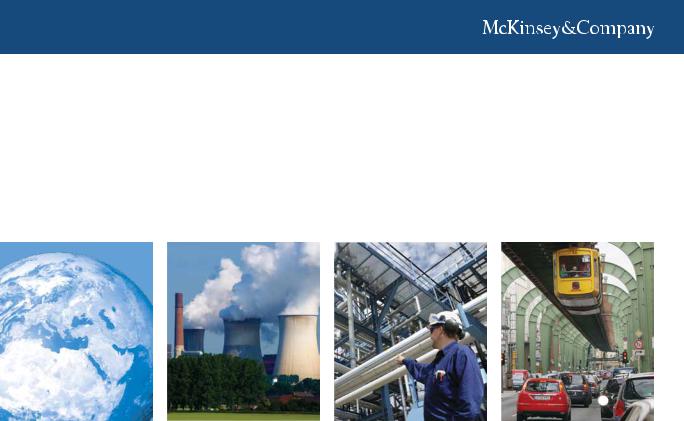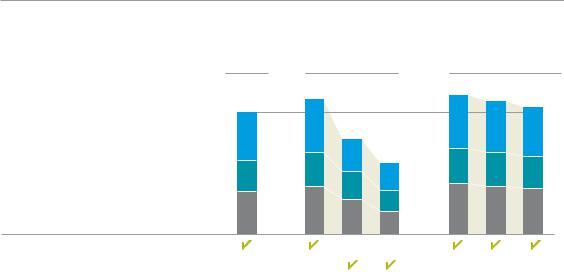
A_Compelling_Global_Resource
.pdf
McKinsey Sustainability & Resource Productivity
Energy efficiency:
A compelling global resource

This compendium was written by McKinsey & Company experts and consultants. McKinsey & Company is a management consulting firm that helps leading organizations in the public, private, and not-for-profit sectors make distinctive, lasting, and substantial improvements in their performance. Over the past eight decades, our firm’s primary objective has remained constant: to serve as an organization’s most trusted external advisor on critical issues facing senior management. 
This publication is not intended to be used as the basis for trading in the shares of any company or for undertaking any other complex or significant financial transaction without consulting appropriate financial advisers. To send comments or request copies of this publication, contact us at Sustainability@mckinsey.com.
Energy efficiency: A compelling global resource
Editorial Board: Shannon Bouton, Jon Creyts, Tom Kiely, John Livingston, Tomas Nauclér
Editor: Tom Kiely
Design Team: Therese Khoury, Sue Rini, Delilah Zak
Cover Design: Therese Khoury
No part of this publication may be circulated, quoted, or reproduced for distribution without prior written approval from McKinsey & Company. Copyright © 2010 McKinsey & Company. All rights reserved.

Energy efficiency:
A compelling global resource
|
Introduction |
2 |
|
Energy efficiency: Unlocking the US opportunity |
4 |
|
||
|
||
|
The energy advantage: How Germany can benefit |
18 |
|
||
|
||
|
Promoting energy efficiency in the developing world |
26 |
|
||
|
||
|
Capturing the lean energy-efficiency opportunity in industrial and |
|
|
|
|
|
|
|
|
manufacturing operations |
30 |
|
Making supply chains energy efficient |
34 |
|
||
|
||
|
Data centers: How to cut carbon emissions and costs |
45 |
|
||
|
||
|
Electrifying cars: How three industries will evolve |
53 |
|
||
|
||
|
Capturing the consumer opportunity in energy-efficient products |
61 |
|
||
|
||
|
|
|

2





 Introduction
Introduction
Globally, energy efficiency represents about 40 percent of the greenhouse gas reduction potential that can be realized at a cost of less than €60 per metric ton of carbon dioxide equivalent (tCO2e).1 In many cases, it is an extremely attractive upfront investment that pays for itself over time, while providing the added benefits of reducing the cost of energy and increasing the energy productivity of the economy. It is not surprising, then, that many governments have emphasized energyefficiency opportunities during the current economic downturn as a way to stimulate their faltering economies. By focusing funding on energy-efficiency initiatives, governments hope not only to save or create jobs—the primary goal of the spending—but also to reduce domestic dependence on foreign energy supplies and reduce carbon emissions associated with energy use.
Interest in energy efficiency is not new. Companies, governments, and consumer groups have sought for years to power more economic activity and residential demand with less energy. While innumerable barriers across sectors have hampered many efforts, there have been some clear successes, such as the growing adoption of energy-saving appliances in many developed markets. In recent years, increased awareness of these pockets of success—along with spiking oil costs, growing national competition for global energy supplies, environmental issues, and the increased stress of growing demand on an aging energy infrastructure—have prompted renewed interest in energy efficiency in many quarters, public and private. The large infusions of public investment in energy efficiency over the past year have only added to the momentum.
This anthology of articles looks at the energy-efficiency opportunity and how to capture it in nations and companies over the next few years. The opportunity to lower energy costs substantially is compelling. The United States, for instance, could realize more than a trillion dollars in energy savings by 2020 if comprehensive efforts are put in place to overcome barriers and improve energy efficiency across the economy. As Hannah Choi Granade, Jon Creyts, Philip Farese, and Ken Ostrowski report in, “Energy efficiency: Unlocking the US opportunity,” the efficiency potential
is highly fragmented across more than a hundred million residential, commercial, and industrial buildings, and billions of devices. Capturing the full value will require investment—about $50 billion more a year for the next decade—and a holistic approach involving information and education, incentives, new codes and standards, and third-party solutions.
1“Pathways to a Low-Carbon Economy: Version 2 of the Global Greenhouse Gas Abatement Cost Curve,” at globalghgcostcurve.bymckinsey.com.

McKinsey Sustainability & Resource Productivity |
|
Energy efficiency: A compelling global resource |
3 |
Governments will play a decisive role in boosting energy efficiency. By refocusing energy policies, developing nations could dramatically reduce the growth of energy demand over the next 12 years without impairing economic growth. In their article “Promoting energy efficiency in the developing world,” Diana Farrell and Jaana Remes observe that reducing energy subsidies, introducing incentives for energy efficiency, and implementing and enforcing new efficiency standards are the three most important elements of a successful energy-efficiency agenda in the developing world.
Industry also will both contribute to and benefit from greater energy efficiency. In their article, “Capturing the lean energy-efficiency opportunity in industrial and manufacturing operations,” Nicole Roettmer, Erik Schaefer, and Ken Somers demonstrate how companies that incorporate a focus on improving energy efficiency in their lean efforts can achieve significant operating cost
reductions. And still more savings are to be found in better managing corporate IT assets, as William Forrest, James Kaplan, and Noah Kinder show in their article, “Data centers: How to cut carbon emissions and costs.”
Similar to the case for industry, energy efficiency can also provide a competitive advantage on a national scale. A new study of the impact of energy efficiency in the German economy reveals that German businesses, particularly in energy-intensive sectors, could gain cost advantages against global competitors if energy productivity improves across the economy. Kalle Greven, Anja Hartmann, and Florian Jaeger provide a summary of this significant study in their article, “The energy advantage.”
Similar thinking needs to be done across sectors. This compendium offers some early perspectives on what we believe will be one of the most important economic shifts in modern times—a transition to a more energy-efficient, low-carbon economy. This is just the beginning of a wave of insights and thinking about how leaders successfully steer their organizations and economies into this new era.
Shannon Bouton
Jon Creyts
John Livingston
Tomas Nauclér

4





 Energy
Energy efficiency:
efficiency: 







 Unlocking the US opportunity
Unlocking the US opportunity
By Hannah Choi Granade, Jon Creyts, Philip Farese, and Ken Ostrowski
The central conclusion of our work: Energy efficiency offers a vast, low-cost energy resource for the US economy—but only if the nation can craft a comprehensive and innovative approach
to unlock it. Significant and persistent barriers will need to be addressed at multiple levels to stimulate demand for energy efficiency and manage its delivery across more than 100 million buildings and billions of devices. If executed at scale, a holistic approach would yield gross energy savings worth more than $1.2 trillion, well above the $520 billion needed for upfront investment in efficiency measures (not including program costs). Such a program is estimated to reduce end-use energy consumption in 2020 by 9.1 quadrillion BTUs, roughly 23 percent of projected demand, potentially abating up to 1.1 gigatons of greenhouse gases annually.
A more efficient use of energy has been the goal of many initiatives within the United States over the past several decades. While specific efforts have had different degrees of success, the trend is clear: the US economy has steadily improved its ability to produce more with less energy. Yet this improvement has emerged unevenly and incompletely within the economy. As a result, net efficiency gains are falling short of their full potential as positive net present value (NPV) investments. Concerns about energy affordability, energy security, and greenhouse gas emissions have heightened interest in the potential for energy efficiency to help address these important issues.
Despite numerous studies on energy efficiency, two issues remain unclear: the magnitude of the NPV-positive opportunity and the practical steps necessary to unlock its full potential. What appears needed is an integrated analysis of energy-efficiency opportunities that simultaneously identifies the barriers and reviews possible solution strategies. Such an analysis would ideally link efficiency opportunities and their barriers with practical and comprehensive approaches for capturing the billions of dollars of savings potential that exist across the economy.
To contribute to these efforts, McKinsey is engaged in ongoing research into opportunities for greater efficiency in energy use in the United States, the barriers to achieving that potential, and possible solutions. This article summarizes the findings from one significant stream of this research,

McKinsey Sustainability & Resource Productivity |
|
Energy efficiency: A compelling global resource |
5 |
conducted by McKinsey, along with leading companies, industry experts, government agencies, and environmental NGOs (nongovernmental organizations).1
Compelling nationwide opportunity
Our research for this study indicates that by 2020, the United States could reduce annual energy consumption by 23 percent from a business-as-usual (BAU)2 baseline projection by deploying an array of NPV-positive efficiency measures. As a result the United States could save 9.1 quadrillion BTUs of end-use3 energy (18.4 quadrillion BTUs in primary energy). This potential exists because significant barriers impede the deployment of energy-efficient practices and technologies. It will be helpful to begin by clarifying the size and nature of this opportunity. Then we will describe the case for taking action to address the barriers and unlock the energy-efficiency potential.
Capturing the full potential over the next decade would decrease the end-use energy consumption this report analyzed4 from 36.9 quadrillion BTUs in 2008 to 30.8 quadrillion BTUs in 2020 (Exhibit 1), with potentially profound implications for existing utility business models.5 The residential sector accounts for 35 percent of the end-use efficiency potential (33 percent of primary-energy potential),
the industrial sector 40 percent (32 percent in primary energy), and the commercial sector 25 percent (35 percent in primary energy). (The differences between primary and end-use potentials are attributable to conversion, transmission, distribution, and transportation losses. We present both numbers throughout because each is relevant to specific issues considered.)
This change represents an absolute decline of 6.1 quadrillion end-use BTUs from 2008 levels and an even greater reduction of 9.1 quadrillion end-use BTUs from the energy consumption level
projected for 2020. If this entire potential is captured, despite the absolute decline in consumption, construction of new power plants, gas pipelines, and other energy infrastructure will be required to address selected pockets of growth, retirement of economically or environmentally obsolete energy infrastructure, and introduction of unaccounted-for consumption such as from electric vehicles. However, energy efficiency could measurably reduce the total new-infrastructure investment required during this period.
1The full report on the conclusions of this research initiative is titled Unlocking Energy Efficiency in the U.S. Economy (July 2009) and is available on mckinsey.com.
2The Energy Information Administration’s Annual Energy Outlook 2008 (AEO 2008) was used for McKinsey’s business-as-usual projection; we use the 81 percent of nontransportation energy with consumption that we were able to attribute to specific end uses (see footnote 3).
3End-use, or “site,” energy refers to energy consumed in industrial, business, and residential settings, which includes providing light, heating and cooling spaces, running motors and electronic devices, and powering industrial processes. By contrast, primary, or “source,” energy represents energy in the form in which it is first accounted (such as BTUs of coal, oil, or natural gas) before transformation to secondary or tertiary forms (such as electricity). From the end-use viewpoint, primary energy is lost during transformation to other forms and in transmission, distribution, and transport to end-users; these losses are an important energy-saving opportunity but one that is outside the scope of this report. Unless explicitly defined as primary energy, energy usage and savings values in this report refer to end-use energy.
4The scope of our analysis was the 81 percent of nontransportation energy in the Annual Energy Outlook 2008 with end-uses that we were able to attribute.
5We examine implications for utility company business models in Chapter 5 of the full report.

6
Beyond the economics, efficiency represents an emissions-free energy resource. If captured at full potential, energy efficiency would abate approximately 1.1 gigatons CO2e of greenhouse gas emissions per year in 2020 relative to BAU projections and could serve as an important bridge to an era of advanced low-carbon supply-side energy options.
Exhibit 1
Significant energy-efficiency potential in the US economy
End-use consumption, quadrillion BTUs
|
36.9 |
39.9 |
30.8 |
|
|
|
|
||
|
|
|
|
|
–23% |
|
|||
Industrial |
|
|
20.5 |
|
|
|
|||
19.3 |
|
|
|||||||
|
|
16.9 |
|
|
–18% |
Contribution by energy source to 2020 efficiency potential, |
|||
|
|
|
|
|
|
|
|||
Commercial |
6.7 |
|
8.0 |
|
|
|
5.7 –29% |
% |
|
Residential |
10.9 |
11.4 |
|
|
|
|
–28% |
|
|
8.2 |
|
||||||||
|
|
|
|
|
|
|
|
|
|
|
|
1,080 TWh |
2.9 TCF |
250 |
|
|
100% = |
|||||||
|
|
|
|
|
|
|
|
|
|
|
|
MBOE |
||||||||||||
|
|
|
|
|
|
|
|
|
|
|
End-use energy |
41 |
|
33 |
|
|
|
|
|
|
|
9.1 quadrillion |
||
|
|
|
|
|
|
|
|
|
|
|
|
|
|
16 |
10 |
|||||||||
Primary consumption, |
|
|
|
|
|
|
|
|
|
|
|
|
BTUs |
|||||||||||
|
|
|
|
|
|
|
|
|
|
|
|
|
|
|
|
|
|
|
|
|
|
|||
quadrillion BTUs1 |
70.8 |
|
|
|
|
|
|
|
|
|
|
|
|
|
|
|
|
|
|
|
18.4 quadrillion |
|||
|
64.7 |
|
|
|
|
|
|
|
Primary energy |
62 |
|
|
|
|
8 |
17 |
|
8 |
5 |
|
||||
|
|
|
|
|
52.4 |
|
|
–26% |
|
|
|
|
|
BTUs |
||||||||||
Industrial |
|
|
28.3 |
|
|
|
|
|
|
|
|
|
||||||||||||
|
|
|
|
|
|
|
|
|
|
|
|
|
|
|
|
|
|
|
|
|||||
27.2 |
|
|
|
|
|
|
|
|
|
|
|
|
|
|
|
|
|
|
|
|||||
|
|
|
|
|
|
|
|
|
|
|
|
|
|
|
|
|
|
|
|
|
|
|||
|
|
|
|
|
22.4 |
|
|
–21% |
Energy costs |
52 |
|
|
6 |
16 |
22 |
|
4 |
|
$130 billion |
|||||
|
|
|
|
|
|
|
|
|
|
|
|
|
||||||||||||
|
|
|
|
20.0 |
|
|
|
|
|
|
|
|
|
|
|
|
|
|
|
|
|
|
||
Commercial |
16.3 |
|
|
|
|
|
|
|
|
|
|
|
|
|
|
|
|
|
|
|
|
|
|
|
|
|
13.6 |
|
|
–32% |
|
|
|
|
|
|
|
|
|
|
|
|
|
|
|||||
|
|
|
|
|
|
|
|
|
|
|
|
|
|
|
|
|
|
|
|
|
||||
Residential |
21.2 |
|
|
22.5 |
|
|
|
|
Carbon emissions |
63 |
|
|
|
|
9 |
15 |
8 |
5 |
|
1.1 gigatons CO2e |
||||
|
|
|
|
16.5 |
|
|
–27% |
|
|
|
||||||||||||||
|
|
|
|
|
|
|
|
|
|
|
|
|
|
|
|
|
|
|
|
|||||
|
|
|
|
|
|
|
Electricity |
|
|
|
CHP Gas Oil |
|
|
Other |
||||||||||
|
|
|
|
|
|
|
|
|
|
|
|
|
|
|
|
|
||||||||
Baseline |
Baseline |
NPV-positive |
|
|
|
|
|
|
|
|
|
|
|
|
|
|
||||||||
case, 2008 |
case, 2020 |
case, 2020 |
|
|
|
|
|
|
|
|
|
|
|
|
|
|
|
|||||||
1Includes primary savings from CHP. Source: EIA AEO 2008, McKinsey analysis
In modeling the national potential for greater energy efficiency, we focused our analysis on identifying what we call the “NPV-positive” potential for energy efficiency. In calculating the NPV-positive potential,6 we considered direct life-cycle energy, operating, and maintenance cost savings, net of equipment and installation costs, regardless of who invests in the efficiency measure or receives the benefit. We used industrial retail rates as a proxy for the value of energy savings in our calculations,7
6See Appendix B in the full report for more details on this calculation methodology.
7Industrial retail rates represent an approximate value of the energy saved as they include generation, transmission, capacity, and distribution costs in regulated and restructured markets. The bulk of the rate is composed of generation cost, with minor contribution from transmission and capacity, and negligible contribution from distribution. The rate represents a slightly conservative estimate of the value of the energy savings because the load factor underestimates the national average, but the other components are closer to probable savings from the realizing of significant energy efficiency. We also computed the avoided cost of gas using an industrial retail rate, which likewise is close to the wholesale cost of gas plus a small amount of transport cost. A more detailed discussion of the avoided cost of energy is available in Appendix B of the full report.

McKinsey Sustainability & Resource Productivity
Energy efficiency: A compelling global resource |
7 |
applied a 7 percent discount factor as the cost of capital, and assumed no price on carbon. This methodology provides a relatively conservative representation of the potential for NPV-positive energy efficiency from the perspective of policy makers and business leaders who must make decisions in the broad interests of society. This is in contrast to some studies that report on technical potential, which applies the most efficient technology regardless of cost, and differs from reports that project achievable potential given historical performance of efficiency programs under an implied set of constraints.
We also acknowledge, however, that there are different views of future scenarios, societal discount rates, and what constitutes “NPV-positive” from the perspective of individual economic actors. Thus we tested the resiliency of the NPV-positive opportunities by adjusting the discount rate (expected payback period), possible carbon price ($0, $15, $30, and $50 per ton CO2e), and the value of energy savings (customer-specific retail prices and marginal long-term energy savings). We found the potential to remain quite significant across all of these sensitivity tests (Exhibit 2). Introducing a carbon price as high as $50 per ton CO2e from the national perspective increases the potential by 13 percent. Applying a discount rate of 40 percent, using customer-class-specific retail rates, and assuming no future cost of carbon reduces the NPV-positive potential from 9.1 quadrillion to 5.2 quadrillion BTUs. This would mean a reduced but still significant potential that would more than offset projected increases in BAU energy consumption through 2020.
Exhibit 2
Sensitivity of NPV-positive energy-efficiency potential
Quadrillion BTUs, end-use energy
Base case |
Time-value of savings |
Savings with carbon price |
||||||
|
|
10.0 |
|
|
10.3 |
9.8 |
9.5 |
|
|
9.1 |
|
|
|
||||
|
|
|
|
|
|
|||
|
|
|
|
|
|
|
||
|
|
4.0 |
7.2 |
|
4.0 |
3.8 |
3.7 |
|
Industrial |
3.6 |
|
|
|||||
|
|
|
|
|
|
|||
|
|
|
2.4 |
5.2 |
2.6 |
|
|
|
Commercial |
2.3 |
2.5 |
|
2.0 |
2.5 |
2.4 |
||
|
|
|||||||
|
|
|
|
|||||
|
2.1 |
|
|
|
||||
|
|
|
|
|
|
|
||
Residential |
3.2 |
3.6 |
|
1.6 |
3.8 |
3.6 |
3.4 |
|
2.6 |
1.7 |
|||||||
|
|
|
|
|
|
|||
|
|
|
|
|
|
|
||
Energy price |
Industrial retail1 |
|
|
|
|
|
|
|
|
Customer retail |
|
|
|
|
|
|
|
|
|
|
|
|
|
|
|
|
Discount factor, % |
|
7 |
4 |
20 |
40 |
7 |
7 |
7 |
|
|
|
|
|
|
|
|
|
Carbon price, $ per ton CO2e |
0 |
0 |
0 |
0 |
50 |
30 |
15 |
|
1AEO 2008 industrial energy prices by census division (national average weighted across all fuels: $13.80/MMBTU) are used as a proxy.
Source: EIA AEO 2008, McKinsey analysis

8
Our methodology provided a more granular examination of the economics of efficiency potential and the barriers to its capture than has been publicly reported. Using the Energy Information Administration’s National Energy Modeling System (NEMS) and its Annual Energy Outlook 2008 (AEO 2008) as a foundation, for each census division and building type we developed a set of business-as-usual choices for end-use technology through 2020. Then, to identify meaningful opportunities at this level of detail, we modeled deployment of 675 energy-saving measures to select those with the lowest total cost of ownership, replacing existing equipment and building stock over time whenever doing so was NPV-positive.8 We disaggregated national data on energy consumption using some 60 demographic and usage attributes, creating roughly 20,000 consumption microsegments across which we could analyze the potential.
By linking our models with usage surveys and research on user-related barriers and consumption patterns we were able to reaggregate the microsegments as 14 clusters of efficiency potential according to sets of shared barriers and usage characteristics. The resulting clusters, as shown in Exhibit 3, are sufficiently homogeneous to suggest a set of targeted, actionable policy solutions and business models.
While not all actions that decrease the consumption of energy represent NPV-positive investments relative to alternatives, as defined by our methodology all the energy-efficiency actions included in this report represent attractive investments. The upfront deployment cost of these NPV-positive efficiency measures ranges upward from $0.40 per MMBTU (million BTUs) saved, averaging $4.40 per MMBTU of end-use energy saved (not including program costs). The average is 68 percent below the AEO 2008 business-as-usual forecast price of saved energy
in 2020, $13.80 per MMBTU weighted average across all fuel types (Exhibit 4), and 27 percent below the forecast lowest delivered natural-gas price in the United States in 2020. Furthermore, the energy and operational savings from greater efficiency total some $1.2 trillion in present value to the US economy: unlocking this value would require an initial upfront investment of
approximately $520 billion (not including program costs).9 Even the most expensive opportunities selected in this study are NPV-positive over the lifetime of the measure and represent the least expensive way to provide for future energy requirements.
Significant barriers to overcome
The highly compelling nature of energy efficiency raises the question of why we have not already captured this potential, since it is so large and attractive. In fact, much progress has been made over the past few decades throughout the United States, with significantly greater-than-average results in selected regions and segments. Since 1980, energy consumption per unit of floor space has decreased 11 percent in residential and 21 percent in commercial sectors, while energy consumption per real dollar of gross domestic product (GDP) has decreased 41 percent. Although these numbers do not incorporate structural changes, many studies indicate that efficiency plays a role in these reductions. As an indicator of this success, recent BAU forecasts have incorporated expectations of greater energy efficiency. For example, the Energy Information Administration’s 20-year consumption forecast shows a 5 percent improvement in commercial energy intensity
8We modeled the energy savings potential of combined heat and power installations in the commercial and industrial sectors separately from these replacement measures.
9The net present value of this investment therefore would be $1.2 trillion minus $520 billion, or $680 billion.
